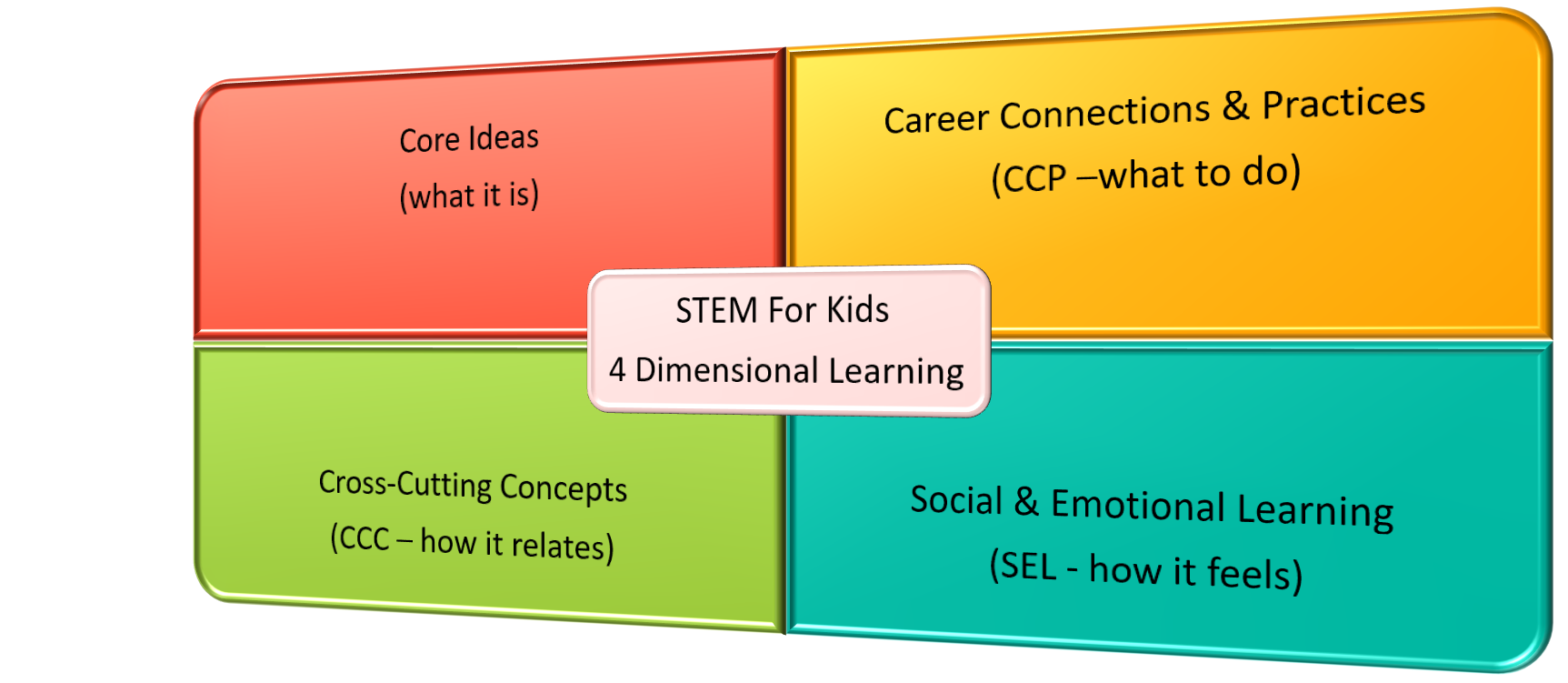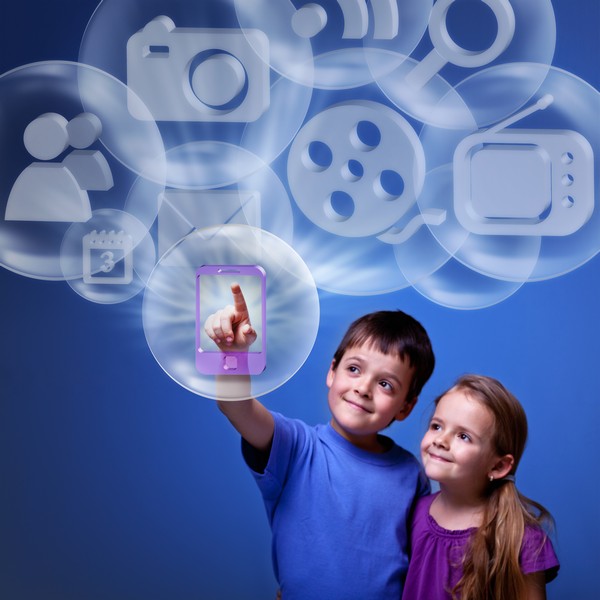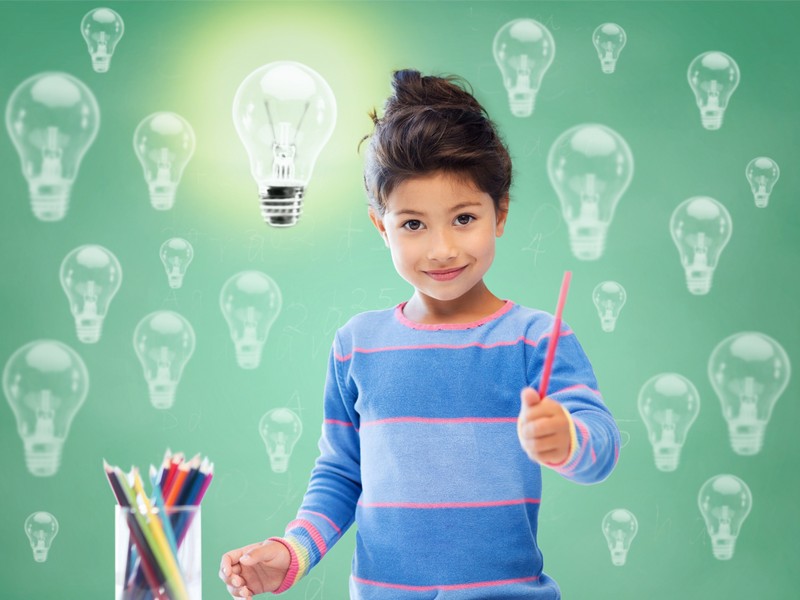STEM For Kids' 4 Dimensional Learning

At STEM For Kids, we provide an engaging learning experience for program participants. Brain research shows that fun and engagement are important ingredients for learning and memory.
How do we do it?
The foundation of our STEM experience is a 4 Dimensional Learning that includes:
Core Ideas, Cross Cutting Concepts (CCCs), Career Connections and Practices (CCPs) and Social Emotional Learning (SEL)
Our modular proprietary curricula allow custom delivery formats and spaces. Our activities provide quality STEM enrichment during in-school time or extended time (out-of-school time).
While our programs take place in a variety of settings – school, community centers, religious centers and online – we are always providing children a fun-filled learning experience with live interaction with their peers and their instructor.
An August 2020 research indicates that STEM For Kids programs are liked by children and their parents:
- 98% parents liked the variety of program themes.
- 95% parents enrolled their child because their child wanted it.
- 94% parents confirm child gained new knowledge, skills and abilities.
- 90% parents confirm that child is thinking critically about technology and creations.
Our comprehensive curriculum portfolio provide different courses to cover a variety of core ideas related to science education. For example:
- our courses in Motion Commotion and Mechanical Engineering cover motion and stability, forces and interactions.
- Aerospace Engineering covers motion, forces and earth science.
- Captain Energypants courses cover energy and aspects of motion and forces.
- Biomedical Engineering courses cover life science, forces and motion.
- Environmental and Sustainable Engineering courses cover ecosystems and energy.
Core Ideas related to the following are also covered through our children-friendly curricula:
- Mathematical Practice – persevere in solving problems, model with math, reason abstractly and quantitatively, and make use of structure.
- Language Arts Practice – comprehension, collaboration, presentation of knowledge and ideas.
- Technology and Computer Science – computational thinking, using technology as a tool to practice teamwork, analyze and communicate, computing practice and programming, computer and communication devices, community, global and ethical impacts.
Computing skills are considered important for 21st Century life and careers. These skills are versatile and apply to many careers directly or indirectly connect with STEM.
In our programs, we provide multiple levels of computer programming beginning with drag-and-drop programming to advanced coding like resume-ready coding in Python and Java programming languages. We also show children how to apply their skills to make computer games, applications, animations, Internet of Things creations, robotics and more.
In our programs, children are encouraged to:
- interact with one another and with their instructor in a structured way
- to think critically about various topics, to traverse the Bloom’s taxonomy up-and-down in their thinking
- to think about their thinking and their learning processes
- to celebrate their failures and to find ways to solve their initial failures
- to persevere in solving problems
- to explore and develop their social and interpersonal skills

Our learning dimension of Career Connection and Practices (CCP), brings depth to the learning experience by emphasizing to children how the learning gets applied in real situations.
What CCPs do we cover?
Career Connections
The 4Cs
Engineering Design Projects
Research
Internet Safety

Our learning dimension of Cross Cutting Concepts (CCC) is derived from the Next Generation Science Standards (NGSS). The CCCs emphasize how the learning relates to other ideas and learning heuristics.
What CCCs do we cover?
Patterns
Cause and Effect
Systems and Models
Scale, Proportion and Quantity
Structure and Function
The colors of STEM need the canvas of 4Cs to be effective. 4Cs represent the practices of Communication, Collaboration, Critical Thinking and Creativity. These practices are needed for success and individual growth. The 4Cs entail:
- Communicating effectively to understand and to be understood.
- Working creatively, designing and innovating.
- Collaborating or working in teams to get things done.
- Thinking critically to achieve higher order of thinking per the Bloom’s Taxonomy.
Our inquiry-based curricula seamlessly incorporate the 4Cs to help participants explore the mechanisms of working and thriving in today’s work environments while being mindful about their learning.
At STEM For Kids, we believe in learning with a purposeful real world career connection. We address the “so what” for program participants.
It is important to show children how a concept that they are learning or a phenomenon that they are observing applies in a real world setting, how it connects to a career or a profession, what type of careers work with that concept, and what type of real world inventions / technologies are a result of applying those concepts. All these aspects address the critical “so what” for children.
Our program curricula is born out of real world problems and challenges handled by people in the industry. Real world connection is a start not an after-thought in our curricula.
Engineering Design Project (EDP) uses a stepped approach to designing and problem solving.
We use EDP in STEM For Kids programs to mimic, to some extent, the real-life RFP (request-for-proposals) process and engineering design. EDP encourages children to engage in an iterative design process of Ask, Imagine, Plan, Create and Improve.
Keeping learning fun and engaging is a foundational principle of our learning experience. Brain research shows that fun is an important ingredient for learning and memory.
The curricula are developed for children with an emphasis on “do”. Activities encourage their hands-on / minds-on engagement so children are an active participant in their own learning. We deploy various strategies including curiosity, experimenting, brainstorming, role-playing, designing, building, coding, etc.
© Copyright 2011-2024 STEM For Kids All Rights Reserved. STEM For Kids is a registered trademark of STEM For Kids, LLC |Franchise Opportunity | REGISTER |Privacy Policy |Terms Of Use |Equal Employment Opportunity
